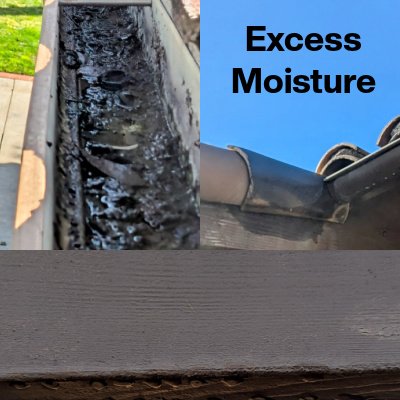Excess Moisture is the Root Cause of Most Termite and Fungus Issues.
 Moisture is the root cause of most termite and fungus issues. While some sources of moisture are unavoidable—like San Diego’s coastal climate and marine layer—others can and should be controlled to prevent long-term damage.
Moisture is the root cause of most termite and fungus issues. While some sources of moisture are unavoidable—like San Diego’s coastal climate and marine layer—others can and should be controlled to prevent long-term damage.
Here are some common causes of excess moisture:Clogged Gutters
This is a major contributor to wood damage. When gutters become clogged, water pools and seeps into adjacent wood, leading to termite infestations and fungus growth. Additionally, when replacing damaged wood, the presence of gutters can increase the cost and complexity of repairs.
Condensation
While you can’t eliminate condensation, you can avoid creating surfaces where it collects. For instance, if you live near the coast, think twice before installing a wooden pergola. Any flat, exposed wooden surface will accumulate moisture, eventually leading to wood rot and termite activity.
Plumbing Leaks
Even the smallest leak can attract termites and cause wood rot. A minor leak under a bathroom sink may seem insignificant, but over time, the moisture can reach the soil beneath your home. This can attract subterranean termites, which travel through foundation cracks and up into your walls.
Irrigation Issues
Misaligned or faulty sprinklers can cause serious damage. Water that constantly hits a home’s stucco or wood siding can lead to rot and termite infestations. Over watering planters adjacent to the house can create ideal conditions for subterranean termites. Even if wooden posts are insulated with cement, excess water at the base can still cause rotting.
Roofing Problems
San Diego may not receive as much rainfall as other areas, but roof leaks are still a major cause of termite infestations and rotting eaves. If roofing materials fail, water can accumulate under the roofing material and damage the plywood beneath. Some roofs have a raised lip at the base, which can act as a dam, trapping water and accelerating wood decay.
AC Condensate Drain Lines
If an air conditioning drain line directs water toward a wooden surface, it can create the perfect conditions for termites, fungus, and wood rot.
Prevention is Key
A termite inspector can identify these moisture issues and recommend treatments and repairs. However, unless the underlying moisture problem is addressed, the damage will reoccur. It’s like treating heart disease with bypass surgery but continuing an unhealthy diet—eventually, the same issues will resurface.
The bottom line: Fix the moisture problem first, then repair the damage it caused.
